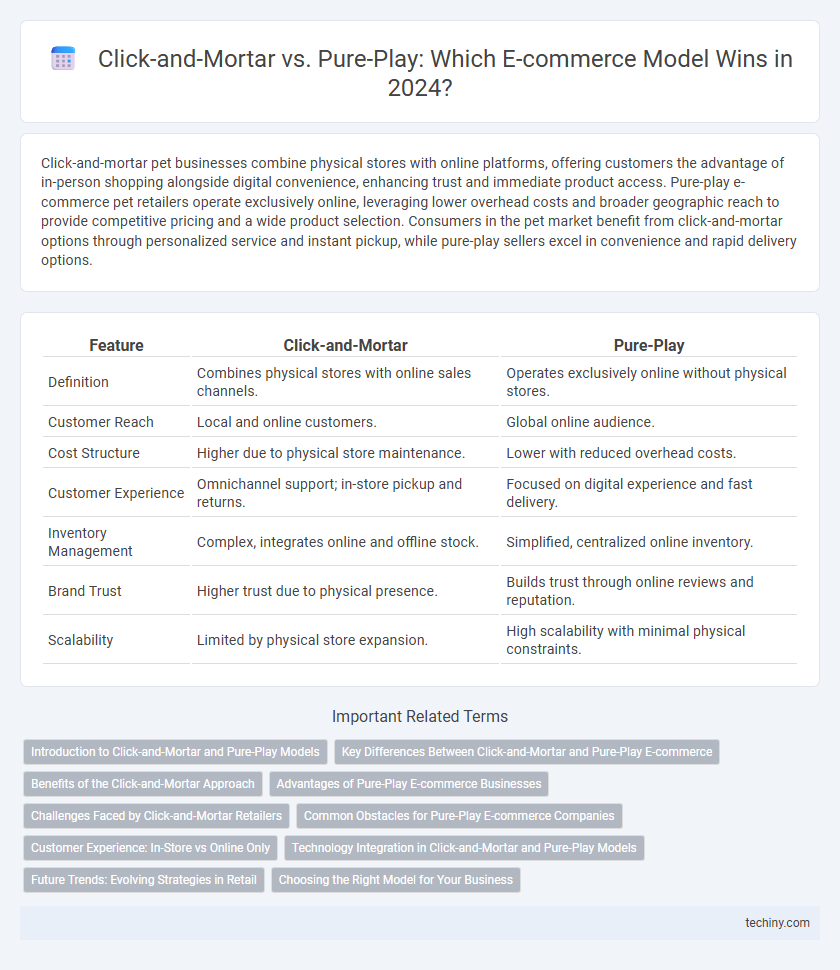Click-and-mortar pet businesses combine physical stores with online platforms, offering customers the advantage of in-person shopping alongside digital convenience, enhancing trust and immediate product access. Pure-play e-commerce pet retailers operate exclusively online, leveraging lower overhead costs and broader geographic reach to provide competitive pricing and a wide product selection. Consumers in the pet market benefit from click-and-mortar options through personalized service and instant pickup, while pure-play sellers excel in convenience and rapid delivery options.
Table of Comparison
| Feature | Click-and-Mortar | Pure-Play |
|---|---|---|
| Definition | Combines physical stores with online sales channels. | Operates exclusively online without physical stores. |
| Customer Reach | Local and online customers. | Global online audience. |
| Cost Structure | Higher due to physical store maintenance. | Lower with reduced overhead costs. |
| Customer Experience | Omnichannel support; in-store pickup and returns. | Focused on digital experience and fast delivery. |
| Inventory Management | Complex, integrates online and offline stock. | Simplified, centralized online inventory. |
| Brand Trust | Higher trust due to physical presence. | Builds trust through online reviews and reputation. |
| Scalability | Limited by physical store expansion. | High scalability with minimal physical constraints. |
Introduction to Click-and-Mortar and Pure-Play Models
Click-and-mortar businesses combine physical storefronts with online platforms, offering customers the convenience of in-person shopping alongside digital purchasing options. Pure-play companies operate exclusively online, leveraging e-commerce technology to reach a broader audience without the overhead of physical locations. The integration of digital and physical sales channels in click-and-mortar models enhances customer engagement, while pure-play models prioritize scalability and cost-efficiency.
Key Differences Between Click-and-Mortar and Pure-Play E-commerce
Click-and-mortar e-commerce combines physical retail stores with online platforms, allowing customers to shop both in-person and digitally, enhancing brand trust and customer experience. Pure-play e-commerce operates exclusively online without a physical storefront, focusing on streamlined digital operations, lower overhead costs, and broader market reach. Key differences include inventory management, customer interaction channels, and logistics, where click-and-mortar businesses leverage in-store pickup and returns, while pure-play relies heavily on efficient delivery systems and digital customer service.
Benefits of the Click-and-Mortar Approach
The Click-and-Mortar approach combines the advantages of physical stores and online platforms, enhancing customer trust through tangible storefronts and personalized service. Retailers benefit from multiple sales channels, increasing market reach and convenience for customers who prefer both in-store and online shopping experiences. Integrating offline and online operations also allows for better inventory management and data collection, leading to optimized marketing strategies and improved customer satisfaction.
Advantages of Pure-Play E-commerce Businesses
Pure-play e-commerce businesses benefit from lower operational costs by eliminating expenses related to physical storefronts, allowing competitive pricing and higher profit margins. They can rapidly scale operations and leverage advanced data analytics to personalize customer experiences and optimize inventory management. Flexibility in market reach enables pure-play models to adapt quickly to changing consumer trends and expand globally with minimal barriers.
Challenges Faced by Click-and-Mortar Retailers
Click-and-mortar retailers face challenges such as integrating seamless online and offline customer experiences, managing inventory across multiple channels, and competing with pure-play e-commerce businesses that often benefit from lower overhead costs. Maintaining consistent pricing and promotional strategies while ensuring robust logistics and delivery systems adds complexity to their operations. Moreover, adapting to rapidly evolving digital marketing trends and consumer behavior requires significant investment in technology and skilled personnel.
Common Obstacles for Pure-Play E-commerce Companies
Pure-play e-commerce companies often face common obstacles such as limited brand recognition compared to click-and-mortar retailers, which can hinder customer trust and loyalty. They frequently encounter challenges in managing logistics and delivery efficiency, impacting customer satisfaction and operational costs. Additionally, pure-play businesses struggle with higher customer acquisition costs due to intense online competition and absence of physical presence to drive spontaneous purchases.
Customer Experience: In-Store vs Online Only
Click-and-mortar retailers blend physical store presence with online platforms, offering customers tactile product interaction alongside convenient digital shopping, enhancing trust and personalized service. Pure-play e-commerce businesses operate exclusively online, emphasizing seamless website navigation, fast delivery, and extensive product information to optimize convenience and accessibility. Both models leverage customer data analytics to tailor shopping experiences but differ in fostering brand engagement through either physical ambiance or digital interface innovation.
Technology Integration in Click-and-Mortar and Pure-Play Models
Click-and-mortar businesses leverage advanced technology integration by combining physical stores with online platforms, using inventory management systems, CRM software, and omnichannel marketing to create seamless customer experiences. Pure-play e-commerce models rely heavily on cloud-based infrastructure, AI-driven personalization, and data analytics to optimize digital sales and customer engagement without physical storefronts. Effective technology integration in click-and-mortar enhances real-time inventory visibility and in-store pickup options, while pure-play models emphasize scalable web architectures and automated logistics for efficient order fulfillment.
Future Trends: Evolving Strategies in Retail
Click-and-mortar retailers are increasingly integrating advanced technologies such as AI-driven personalization and augmented reality to create seamless omnichannel experiences, blending physical and digital touchpoints. Pure-play e-commerce companies are investing heavily in logistics optimization and data analytics to enhance delivery speed and customer insights, positioning themselves for agile adaptation to market shifts. Both models are embracing sustainability initiatives and direct-to-consumer approaches to meet evolving consumer demands and foster long-term loyalty.
Choosing the Right Model for Your Business
Click-and-mortar businesses combine physical stores with online platforms, offering customers a seamless shopping experience and increased trust through tangible presence, while pure-play e-commerce operates exclusively online, enabling lower overhead costs and broader market reach. Evaluating factors such as target audience, budget, competitive landscape, and product type is crucial in selecting the optimal model for sustainable growth. Integrating robust digital marketing strategies and user-friendly interfaces further enhances customer engagement regardless of the chosen business structure.
Click-and-Mortar vs Pure-Play Infographic

 techiny.com
techiny.com